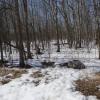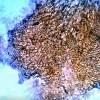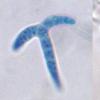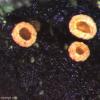
20-12-2025 23:08
Patrice TANCHAUDBonsoir, récolte sur sol sablonneux dans l'arri�

21-12-2025 09:32
Hello.A tiny ascomycete found embedded in wood in

20-12-2025 15:47
Mirek GrycHi.These grew on pine wood that was heavily covere

18-12-2025 21:17
Pol DebaenstThe identification took me to Byssonectria deformi

15-12-2025 07:09
 Danny Newman
Danny Newman
indet. Rutstroemiaceae sp. on unk. fallen leavesMc

19-12-2025 10:10
Patrice TANCHAUDBonjour, récolte réalisée en milieu dunaire, a

18-12-2025 17:23
 Bruno Coué
Bruno Coué
Bonjour,je serais heureux d'avoir votre avis sur c
asco orange avec possible anamorphe inusité
M Jonathan,
07-04-2014 02:06
anamorphe avec conidie en forme de T avec plusieurs septae, trouvé a proximité des asco,mes et pourrait être leur anamorphe. aucune autre structure trouvé et conidie peut commune(environ une dizaine d'observé)
récolté sur de l'écore pourri et humide dans la neige le 6 avril.
http://www.flickr.com/photos/31366379@N05/13674884015/ (télémorphe)
http://www.flickr.com/photos/31366379@N05/13676291824/in/photostream/ (textura télémorphe)
http://www.flickr.com/photos/31366379@N05/13675981253/in/photostream/ (conidie)
http://www.flickr.com/photos/31366379@N05/13675938975/in/photostream/ (conidie)
http://www.flickr.com/photos/31366379@N05/13675934145/in/photostream/ (conidie)
amitié
Jonathan M
Hans-Otto Baral,
07-04-2014 09:42

Re : asco orange avec possible anamorphe inusité
Hello
where are you from? Could it be that the bark belongs to Ulmus?
I suspect Orbilia pilifera, an undescribed taxon not rare in Atlantic-Mediterranean regions of Europe, being confined to Ulmus and occurring often in vast number.
You could keep the sample in a moist box to get mature spores. Then please mount them in water without ingredients: the fusoid spores contain a large refractive spore body that is destroyed in lethal mounting media such as Cotton Blue/lactophenol.
I attach here your photo to see them more conveniently. The photo of a forest with snow belongs also to this fungus?
Zotto
where are you from? Could it be that the bark belongs to Ulmus?
I suspect Orbilia pilifera, an undescribed taxon not rare in Atlantic-Mediterranean regions of Europe, being confined to Ulmus and occurring often in vast number.
You could keep the sample in a moist box to get mature spores. Then please mount them in water without ingredients: the fusoid spores contain a large refractive spore body that is destroyed in lethal mounting media such as Cotton Blue/lactophenol.
I attach here your photo to see them more conveniently. The photo of a forest with snow belongs also to this fungus?
Zotto
M Jonathan,
07-04-2014 15:59
Re : asco orange avec possible anamorphe inusité
thank you Otto, i do not thimk the host is Ulmus, but i do not know much about trees and it is hard to identify a piece of bark in the snow.
They are in moist chamber, i hope they will get mature.
The snow picture is not related however. (but it looked like that in the wood, i am from Ottawa, canada).
Would you think the Anchor shaped conidia are from its anamorph, or unrelated?
They are in moist chamber, i hope they will get mature.
The snow picture is not related however. (but it looked like that in the wood, i am from Ottawa, canada).
Would you think the Anchor shaped conidia are from its anamorph, or unrelated?
Hans-Otto Baral,
07-04-2014 17:41

Re : asco orange avec possible anamorphe inusité
Yes, these anchor conidia (good comparison!) belong to the Orbilia. There are some further species with such conidia but they are all more from subtropical regions. So this could be the first record from America.
How do the paraphyses look? They should be spathulate to mammiform in O. pilifera. Also a microphoto of the hairs would be helpful. But first we must be patient that asci get mature.
Ulmus os often overlooked. On your unrelated photo the trees could be Ulmus, I am not sure. If you happen to visit the place again, look for leaves from the previous year. Ulmus leaves have an asymmetrical base.
Zotto
How do the paraphyses look? They should be spathulate to mammiform in O. pilifera. Also a microphoto of the hairs would be helpful. But first we must be patient that asci get mature.
Ulmus os often overlooked. On your unrelated photo the trees could be Ulmus, I am not sure. If you happen to visit the place again, look for leaves from the previous year. Ulmus leaves have an asymmetrical base.
Zotto
MARIA VIRGINIA BIANCHINOTTI,
07-04-2014 17:45
Re : asco orange avec possible anamorphe inusité
Hello! the anamorph genus is Trinacrium. One of the so-called aero-aquatic hyphomycetes.
Regards
Virginia
Regards
Virginia
Hans-Otto Baral,
07-04-2014 18:26

Re : asco orange avec possible anamorphe inusité
Yes, this is right, and there is a species that fits quite well: Trinacrium incurvm Matsushima.
Now, we distinguish several teleomorph species that have very similar conidia as T. incurvum, so they are quite indistinguishable from the anamorph alone. A rather difficult situation.
Now, we distinguish several teleomorph species that have very similar conidia as T. incurvum, so they are quite indistinguishable from the anamorph alone. A rather difficult situation.
M Jonathan,
07-04-2014 18:28
Re : asco orange avec possible anamorphe inusité
You guys , while never cease to amaze me in fungus identification, congrat! This show also how far away behind europe , eastern north america is.
Last thing, did collection of O pilifera in france showed a trinacrium anamorph?
thank you all!
regards
Jonathan M
Last thing, did collection of O pilifera in france showed a trinacrium anamorph?
thank you all!
regards
Jonathan M
MARIA VIRGINIA BIANCHINOTTI,
07-04-2014 18:43
Re : asco orange avec possible anamorphe inusité
Yes, I agree. The problem is that conidia are very varible. I´ve seen some T. subtile conidia very alike.
Any idea of dimensions?
Any idea of dimensions?
Hans-Otto Baral,
07-04-2014 19:38

Re : asco orange avec possible anamorphe inusité
Yes, we have actually not much Orbilias from NE-America, but many many from SW!
And yes, the anamorph of pilifera was seen on the substrate as well as in pure culture. A very similar species is known from China, etc...
And yes, the anamorph of pilifera was seen on the substrate as well as in pure culture. A very similar species is known from China, etc...
M Jonathan,
15-04-2014 21:54
Re : asco orange avec possible anamorphe inusité
A single apothecia decided to grew to maturity... Information and measurement on the right
http://www.flickr.com/photos/31366379@N05/13879113234/in/photostream/
http://www.flickr.com/photos/31366379@N05/13879113234/in/photostream/
Hans-Otto Baral,
25-04-2014 10:44

Re : asco orange avec possible anamorphe inusité
I am sorry I overlooked your posting. Now we are quite sure that this is Orbilia pilifera. Only we cannot see your measurements and info. How to get access?
Zotto
Zotto




